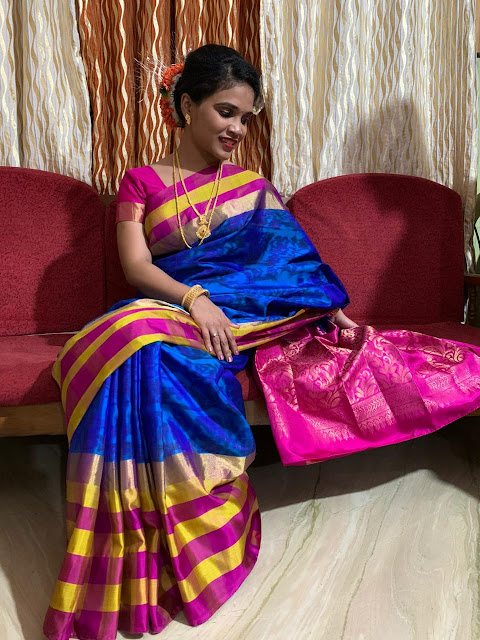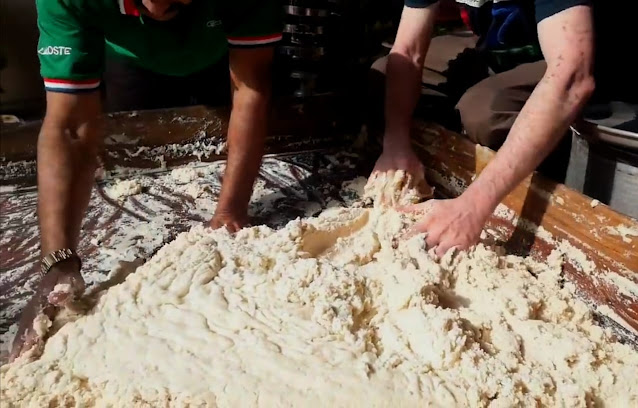Talnayo Rotyo - Vadas doused in oil, roles and traditions
Naomi Fargose
SYBA 2019
 |
| Rotyos |
It was the summer of
2016. I had recently finished my 10th boards and had a four month long vacation
staring at me. Moreover, we had shifted into a new locality and my mother left
no stone unturned in getting me out of the house to "make new
friends". There was a wedding in the village and by the end of the day I
found myself walking to the house of the bride to help with the tradition of
cooking तळणाची रोट.
Weddings, I realized, are
the nexus of music, food, dance and most importantly, people. On entering the
bride's house, I was guided to the backyard where a shamiana had been set-up
for all the cooking that was to happen. Very similar to a vada,
the तळणाची रोट has
twice the amount of oil and is made out of urad dal and rice
flour. The making of this food item, however, is confined only to a marriage
celebration.
It isn't a food dish that is cooked and consumed regularly. Receiving a bunch of rotyos signifies the commencement of the countdown to a marriage. This तळणाची रोट, though a very simple dish in itself, is one that I chose to associate my identity with due to the historical and community contexts that accompany it. To understand the relation between food, community identity and individual identity better, I will share the steps involved in making these rotyos.
 |
| The bride on the day of her first bann, adorned with a flower "jhela" : a symbol of married life. |
Step 1 : पैली शिटी आन आंबो पाडणे
(First wedding bann and felling the mango tree)
The priest announces the
marriage in the church, three weeks prior. On the next day, the bride's father
goes around in the village, informing the people and asking men, in particular,
to help join in the felling of a mango tree.
As the men chop the branches, the women sing traditional songs celebrating the happy occasion. The women then spread the chopped wood for drying while the men happily indulge in alcohol. A spirit of togetherness and solidarity is observed amongst everyone in the village, right from the corporate employee to the daily wage farmer who come together for this ceremony.
 |
| Men kneading dough for the vadas. |
Step 2 : डाळी टाकणे (
Kneading dough trays)
In the week preceding the
marriage, the wood from the mango tree felled earlier is gathered and on a
decided date, night onwards, is used to light fire for the making the rotyos.
The tradition of making talnayo rotyo is
restricted to the night since everyone in the village works throughout the day
in the fields. Moreover, emphasis is placed on the availability of the villagers
rather than those of the family's immediate relatives. This creates a very
strong sense of community while ensuring that everyone in the village stays on
good terms with each other.
On the decided day, in
the afternoon, a group of men are called over to knead the dough for the rotyos in
large trays. Some of these men are famously known for their 'kneading skills'
and are specially invited by the bride's father. Here, we can see the
hierarchies that exist between the villagers in terms of kneading abilities. A
very apparent division of gender roles is seen at this step where only the men
are allowed, or as an unwritten norm - expected to be involved in the kneading
of the dough. This is made on the basis of the assumption of men having greater
physical strength. Once again, the women sing traditional songs describing the
event. The lyrics of some of these songs involve prayers for the dough to rise
well, for providing the men kneading with strength and for the groom's family
to like these rotyos.
 |
| The cooking going on in full swing under the shamiana. |
Step 3 : तळन (frying)
|
After about seven to eight hours, when the dough rises, four to five
huge kadhais are filled with oil and the dried wood of the chopped mango tree
is used to light the fire. One person, usually an elderly woman who cannot
work as much as the others, is given the responsibility of distributing the
dough to everyone from one vessel. Around one kadhai sits a group of about
five to six women who mould the dough and put it for frying. Every group is
allotted with two men with huge spoons who are responsible for stirring the
oil, collecting these rotyos and transferring them to the basket near-by.
Gender roles here are so highly ingrained that one cannot question why at
this stage. Power dynamics around the kadhai exist in very peculiar ways. Only the
very experienced group of women sit the closest to the kadhai. The newbies
are first expected to master the shape of the roti and get it approved by an
elderly woman. Though young teenagers aren't as involved at this stage, their
participation is highly appreciated. Young girls sit besides their mother and
grandmother, who teach them how to make the perfect roti. Similarly, young
boys are called upon to observe the men handling the spoons. It is here where
the seeds of gender roles are first sown. |
 |
| Frying the vadas. Notice that only the men are in charge of the ladles. |
 |
| Sorting and packing the rotyos for distribution. |
Step 4 : पुड्यो आन वाटणी (Packaging
and Distribution)
Amateurs and youngsters
like me are generally allotted this task of packing the rotyos into
bags and carrying them to the groom's house for distribution. At this step,
there is usually a family relative assigned with the youngsters to guide them.
The number of rotyos in each bag differs according to the
receiver's relation and proximity to the soon to be married couple's families.
The groom's family's packages are filled with a complimentary sweet dish. These
special packages are given to members of the bride's family who personally
handled them over to the groom's family. Here, we see the power dynamics in
terms of how much significance is given to a given relation. The arrival of
these packages at the groom's house is a matter of great pomp. A larger number
of rotyos is said to signify both, the expertise of the
bride's family as well as an idea to the number of relations the groom has.
Earlier, it was mandatory
for solely the bride's family to send these rotyos to the
groom's side and was seen as a display of the power and influence. However, in
recent times, both the bride and groom's families have started exchanging
these rotyos with each other. Though the roti, in itself,
doesn't hold as much value, the entire process of involving people, adhering to
rituals and carrying them ahead as a tradition, gives this dish the importance
that it holds.
Being a mediocre dish
with relatively cheap ingredients, its production is affordable to almost all families.
The sole aim behind making this dish is to initiate the celebrations leading to
the marriage, create cohesion amongst the parties involved and ensure the
carrying forward of old traditions, rituals and stories by every generation.
The importance of this dish for me is linked to the ways in which it helped me place myself in the larger society. By participating in the making of these rotyos, I was accepted into the new locality. Bonds were formed around the kadhai and I was termed as an able, social being by the villagers which further gave me and my family the recognition of being 'one of the villagers' and not some 'other'. Due to my consumption of this dish, I was allowed to posses the community identity, that of being a vasaikar. As Michael Pollan summarizes, "Food is not just fuel. Food is about family, food is about community, food is about identity. And we nourish all those things when we eat well."
Being an active participant in the
production and consumption of rotyos,
I gained for myself, an identity.
Of who I was, am and could be.
Cause irrespective of your house and
street,
"You are what you eat."
References :
Appadurai,
A. (1988). How to Make a National Cuisine: Cookbooks in Contemporary India.
Comparative
Studies In Society And History, 30(1), 3-24. doi: 10.1017/s0010417500015024
How
to make East Indian Vade_वडे| Kupari Talanayo Rotyo_तळनायो रोयो.
(2020). Retrieved
25
January 2020, from https://youtu.be/ErtYJUWHD4M
Michel
pullen quote food - Google Search. (2020). Retrieved 24 January 2020, from
https://www.google.com/search?q=Michel+pullen+quote+food&client=ms-android-huawei&pr
md=insv&source=lnms&tbm=isch&sa=X&ved=2ahUKEwiusuSB_qLnAhU-63MBHWn_BYw
Q_AUoAXoECAwQAQ&biw=360&bih=524&dpr=3#imgrc=MYDb2i0qJJ3i7M
Retrieved
24 January 2020, from
https://www.researchgate.net/publication/235306263_A_Heavy_Burden_of_Identity_India_Foo
d_Globalization_and_Women
Waters,
V. (2020). Identity–You Are What You Eat (Part V). Retrieved 27 January 2020,
from
http://www.ethnography.com/2017/04/identity-you-are-what-you-eat-part-v/



Comments
Post a Comment